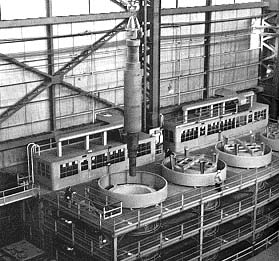Heattreating: Equipment
|
Forging positioned over one of a battery of four pit-type heat treating furnaces. Courtesy of U.S. Steel |
Equipment
Combustion Technology
Energy Consumption
Process Description
R&D Trends
There are several common types of heat treating furnaces. There are batch furnaces and continuous furnaces.
Batch Furnaces
Car Bottom Furnace
Car bottom furnaces are used for heat treating bar stock in bar mills, plate that is too thick for the continuous lines (more than 2″ thick), and annealing of tube stock for multiple cold pass drawing. Direct top and bottom firing gives a temperature range up to 1940°F. For hardening furnaces, heavy insulation is desirable because cooling is achieved by quenching, but for certain other cycles that require rapid cooling, common practice calls for furnaces that have rapid heat loss after firing ceases. Slower cooling is achieved by partial firing.
Box Annealing Furnace
Box annealing furnaces (also referred to as bell furnaces) have a rectangular or circular base for coil annealing of cold reduced strip. The base is cast iron or refractory lined. The removable box furnace contains the burners and exhaust stack. One cover may be designed for use with more than one base. Inner covers are placed over the stacked coils; a protective atmosphere is maintained within these inner covers. A sealing material such as sand, oil, or a low melting allow is used to seal the top to the base to keep air out. Annealing cold reduced strip requires the furnace to be under fire for 30 to 90 hours with the hottest part of the coil reaching 1275°F to 1350°F for 20-50 hours and the coldest part reaching 1225°F to 1275°F for 10 to 20 hours.
Vertical Pit Furnace
The manufacture of heavy press forgings such as steam-turbine rotors, generator shafts, and similar shaft type forgings often utilize vertical pit type heat-treating furnaces. The shaft is lowered through the top of the furnace and rests on special hearth casting and is stabilized by pins inserted through the side of the furnace. Tangential burners provide the heat without direct flame impingement on the work. A typical heating cycle involves a heating period, a soaking period, a second higher temperature soaking period, and then a controlled cooling period. A complete cycle can last from one to eight days.
Continuous Furnaces:
Roller Hearth
Roller hearth furnaces are used in plate mills, tube mills, and bar mills for hardening, normalizing, and tempering operations. Heat resistant steel rollers move the plates (100″ wide by 30′ long, 3/4 to 2″ thick) through the furnace. Temperature control (Hardening 1250-1750°F, Tempering 750-1250°F, stainless, 1250-2100°F) depends on the process. After exiting the hardware furnaces, the plates are rapidly water quenched. Plates treated in this fashion are typically returned to a similar furnace for tempering. Roller hearths can also be operated on a semi-continuous basis with several heating and soaking zones.
Continuous Strip Annealing Line
Cold reduced strip can also be annealed on large continuous processing lines in which the continuous strip makes several passes through the heating towers, under protective atmosphere. The continuous annealing lines use a combination of direct fired heating and radiant tube heating zones. Very similar configuration is used for galvanizing lines. The continuous heat treating furnace on a galvanizing line serves three functions: reduction of the surface oxides by heating in a controlled atmosphere, heating of the steel to just above the temperature of the of the molten zinc bath, and controlling the cooling of the sheet to the zinc-pot temperature and below so the required coating thickness is achieved.
Induction Heaters
Induction heating is done by passing a high-frequency alternating current through a coil surrounding the material to be heated. The resulting electrical field causes rapid heating of the steel due to eddy currents and hysteresis. Induction heating is more commonly used for heating bar stock in the forging industry. In the Steel industry, induction heating is used for rail hardening and certain strip heating applications. Induction heating is used to apply heating and hardening for the head of the rails only.

